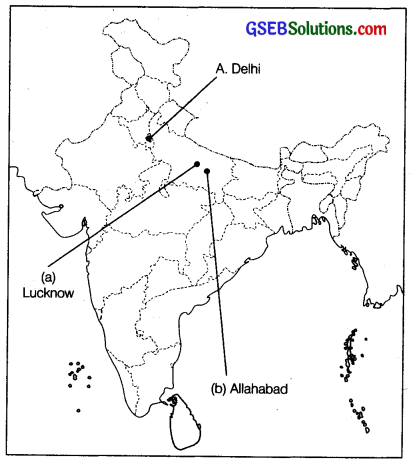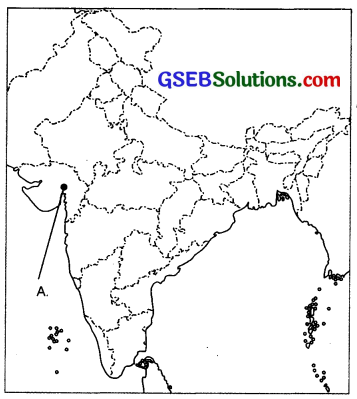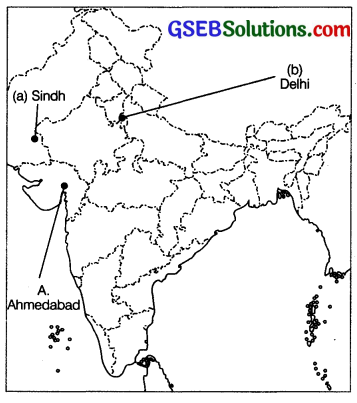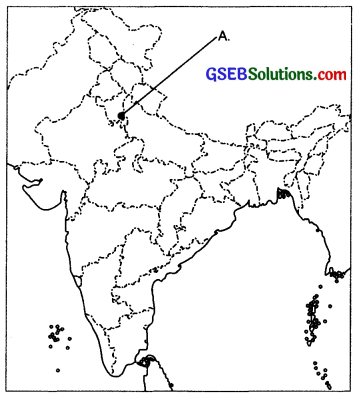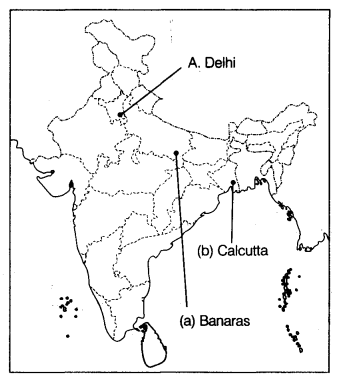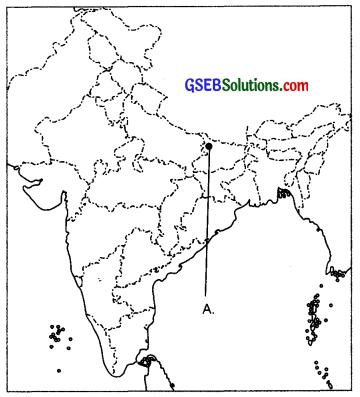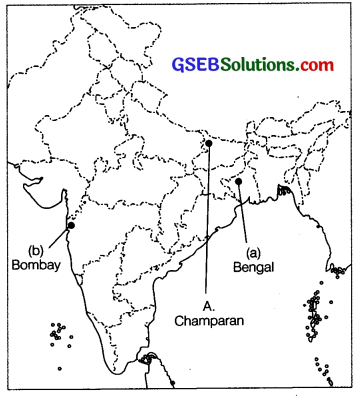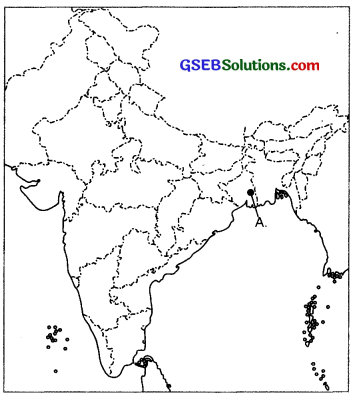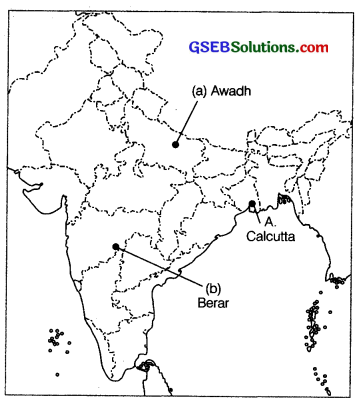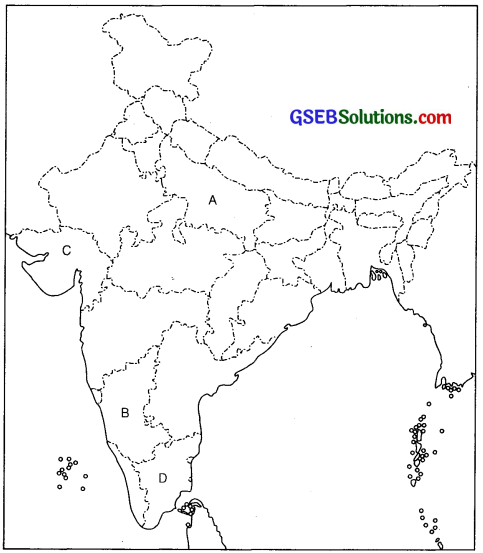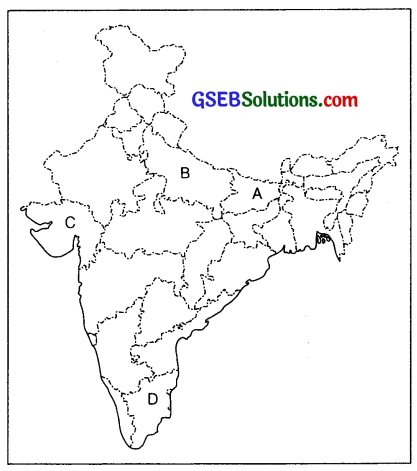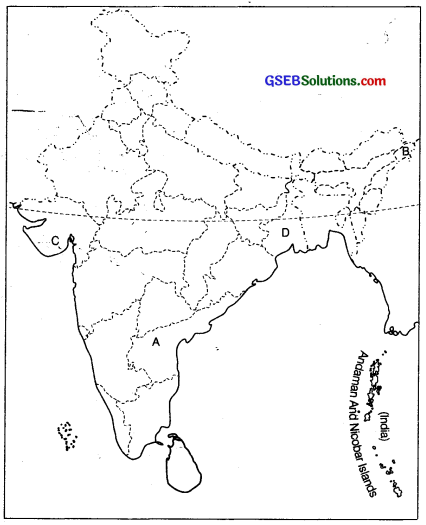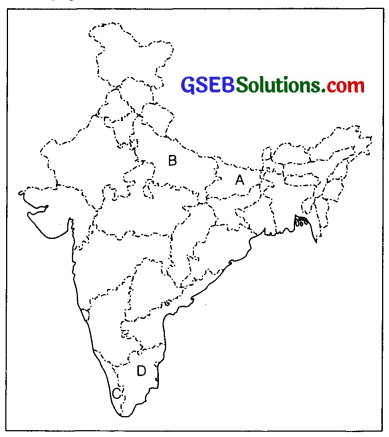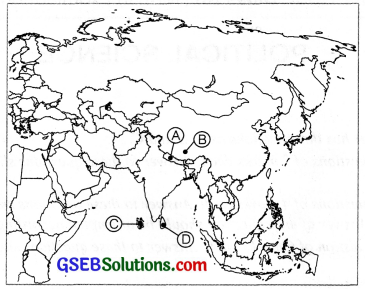Students can access the CBSE Sample Papers for Class 12 History with Solutions and marking scheme Term 2 Set 5 will help students in understanding the difficulty level of the exam.
CBSE Sample Papers for Class 12 History Term 2 Set 5 with Solutions
Time allowed: 2 Hours
Maximum Marks: 40
General Instructions:
- This Question paper is divided into four sections-Section A, B, C and D.
- All questions are compulsory.
- Section-A: Question no. 1 to 4 are Short Answer type questions of 3 marks each. Answer to each question should not exceed 80 words.
- Section-B: Question no. 5 to 7 are Long Answer type questions, carrying 6 marks. Answer to this question should not exceed 150-200 words.
- Section-C: Question no. 8 and 9 are Case Based questions, carrying 4 marks each with subparts.
- Section-D: Question no. 10 is map based, carrying 2 marks.
- There is no overall choice in the question paper. However, an internal choice has been
provided in a few questions. Only one of the choices in such questions have to be attempted. - In addition to this, separate instructions are given with each section and question, wherever necessary.
Section A
Short Answer Questions
Question 1.
How did titles and gifts define the hierarchy of social status among the Mughal elites? (3)
Or
Write a note on the mansabdari system under the Mughals.
Answer:
The granting of titles to men of merit was an important aspect of the Mughal polity. A man’s ascent in the court can be traced by the titles he held in the following ways
(i) The title Asaf Khan was for the highest ministers originated from Asaf.
(ii) The title Mirza Raja was accorded by Aurangzeb to his highest ranking nobles Jai Singh and Jaswant Singh.
![]()
(iii) Other awards included robe of honour (khilat) a garment once worn by the emperor which included his blessings. One gift was the Sarpa consisted of a tunic, a turban and a sash. Jewelled ornaments were often given as gifts by the emperor. The lotus bossom set with jewels (Padma Murassa) was given only in exceptional circumstances.
Or
Mansabdari system was an important aspect of the Mughal polity. All holders of government offices held ranks (mansabs) comprising two numerical designations. Zat which was an indicator of the position in the imperial hierarchy and the salary of the official (mansabdar) and sawar which indicated the number of horsemen he was required to maintain in service. In the seventeenth century, mansabdars of 1000 zat or above ranked as nobles (umara).
The nobles participated in military campaigns with their armies and also served as officers of the empire of the provinces. Each military commander recruited the cavalry. The troopers maintained superior horses branded on the flank by an imperial mark (dagh).
The emperor personally reviewed the changes in rank titles and postings for all except low ranking officers. Akbar designated the mansab system which was continued by other Mughal rulers.
![]()
Question 2.
There was conflict between the Paharias and settled cultivators in the colonial rule. Explain.(3)
Answer:
There was a constant conflict between the Paharis and the settled cultivators. With their base in the hills, the Paharias regularly raided the plains where settled agriculturists lived. These raids were necessary for survival, particularly in the years of scarcity .
They were a way of asserting authority over settled communities and they were a means of negotiating political relations with outsiders. The zamindars on the plains had to often purchase peace by paying a regular tribute to the hill chiefs.
Traders similarly paid amount to the chief of hill folk the paharis for permission to use the passes controlled by them. Once the toll was paid, the Paharias chiefs protected the traders ensuring that the goods were not plundered by anyone.
The settled agriculture expanded the area under the forests later on were contracted. This sharpened the conflict between hill folk and the settled cultivators. The Paharias began to raid the settled villages with increasing regularity, carrying away food grains and cattle.
Thus, the conflict between the paharis and the settled cultivators increase which forced British to embark a brutal policy of extermination, hunting the Paharias down and killing them.
![]()
Question 3.
Who was Francis Buchanan? Why was he viewed with suspicion and distrust by the Paharias?(3)
Answer:
Francis Buchanan was a physician who came to India and served the Bengal Medical service from 1794 to 1815. For a few years, he was a surgeon to the Governor General of India, Lord Wellesley. During his stay at Calcutta, he organised a zoo which became Calcutta Alipore Zoo. He also was in charge of the Botanical gardens for a short period.
On the request of the government of Bengal he undertook detailed surveys of the areas under the jurisdiction of the British East India Company. In 1815 he fell ill and returned to England. He is also referred to as Buchanan – Hamilton.
When Buchanan travelled through the region of Paharias he was viewed with suspicion and distrust. The experience of pacification campaigns of the British and memories of repression shaped the perception of British infiltration in the area where Buchanan was no exception.
Question 4.
Why was Non-Cooperation Movement launched by Mahatma Gandhi?(3)
Answer:
Gandhi launched the Non-Cooperation Movement because
(i) The first reason was the Rowlatt Act. On the recommendation of a committee chaired by Sir Sidney Rowlatt, the Rowlatt Act was passed. It was also called the Anarchical and Revolutionary Act of 1919 by the imperial legislative council at Delhi. The act allowed certain political cases to be tried without juries and permitted internment of suspects without trial.
![]()
(ii) Jallianwala Bagh Tragedy was the second factor responsible for the launch of Non-Cooperation Movement by Gandhi. In April 1919, in Amritsar a British Brigadier ordered his troops to open fire on a nationalist meeting. More than four hundred people were killed in what was known as the Jallianwala massacre.
Section B
Long Answer Questions
Question 5.
The Indian National movement gained a national character after the arrival of Mahatma Gandhi. Justify (6)
Answer:
The arrival of Mahatma Gandhi broadened the base of Indian National Movement in the following ways
(i) Under the leadership of Mahatma Gandhi, the National Movement did not merely remain a movement of the intellectuals and the professionals. Thousands of farmers, labourers and artisans started participating in it. Hence, soon it became a mass movement.
(ii) Gandhiji lived a simple life which was liked by the common people. He wore clothes like a poor farmer or a worker. His way of living was also like a common man. He believed in simplicity. All these inspired the common people.
(iii) The rumours that spread about the miracles of Gandhiji made him very popular. He had become a household name due to which most of the people jumped in the struggle for freedom and whole heartedly participated in the National Movement for freedom.
(iv) Moved by Gandhiji’s call, women began to participate in the National Movement. In urban areas, they came from high caste families and in rural areas, they came from rich peasant households. In this way, Gandhiji changed the way of Indian politics.
Question 6.
How did the Subsidiary alliance pave the way for the annexation of Awadh? What were the features of Subsidiary Alliance? (6)
Or
Explain the privileges enjoyed by the taluqdars of Awadh. How did the annexation of Awadh destroy the prominence of taluqdars?
Answer:
The Subsidiary Alliance imposed on Awadh in 1801 paved way for the annexation of the territory in the following ways
(i) By the terms of the Subsidiary Alliance the Nawab had to disband his military force allow the British to position their troops within the kingdom and act in accordance with the advice of the British resident who was now to be attached to the court.
(ii) Deprived of his armed forces, the Nawab became increasingly dependent on the British to maintain law and order within the kingdom. He could no longer assert control over the rebellious chiefs and taluqdars.
Question 7.
The Constitution preceeded years of abject disappointment. How did it emerge as a source of aspiration of freedom fighters in India? (6)
Or
Why was the question of separate electorates raised by B Pocker Bahadur in 1947? How did Sardar Vallabhbhai Patel and RV Dhulekar react to the demand?
Answer:
The privileges enjoyed by the taluqdars of Awadh before the coming of British
- The countryside of Awadh was dotted with the estates and forts of the taluqdars who had controlled power in the countryside for many generations.
- Before the coming of the British taluqdars maintained armed retainers, built forts and enjoyed a degree of autonomy as long as they accepted the suzerainty of the Nawab and paid the revenue of the taluqs.
- Some of the bigger taluqdars had around 12000 foot soldiers and even smaller ones had about 200.
Steps taken by the British to reduce the prominence of the taluqdars were
(i) The British were unwilling to tolerate the power of the taluqdars. Immediately after the annexation the taluqdars were disarmed and their forts destroyed.
(ii) The British revenue policy undermined the position and authority of the taluqdars.
(iii) The Summary Settlement of the Britishers was based on the assumption that the taluqdars were interlopers with permanent stakes in land and that they had established hold over land through force and fraud. The Summary Settlement proceeded to remove the taluqdars wherever possible.
(iv) The British land revenue officers believed they would be able to settle the land with actual owners of the soil and thus reduce the level of exploitation of the peasants while increasing land revenue returns for the state.
Section – C
Source Based Questions
Question 8.
Read the source given below and answer the following questions.
Nobles at Court :The Jesuit priest Father. Antonio Monserrate, resident at the court of Akbar, noticed: In order to prevent the great nobles becoming insolent through the unchallenged enjoyment of power, the King summons them to court and gives them imperious commands, as though they were his slaves.
The obedience to these commands ill suits their exalted rank and dignity. What does Father Monserrate’s observation suggest about the relationship between the Mughal emperor and his officials?
(i) Who was Antonio Monserrate? (1)
(ii) Why members of nobility did not join imperial services? (1)
(iii) Who were Jesuits? (2)
Answer:
(i) Antonio Monserrati was a Portuguese priest.
(ii) The members of the nobility did not join imperial service because of becoming the emperor by seizing power.
(iii) Jesuits were missionary workers who belonged to the Roman Catholic Church. They were also the members of the Society of the Jesus, but they were not part of protestant catholics.
![]()
Question 9.
Read the source given below and answer the following questions.
Ordinary Life in Extraordinary Times What happened in the cities during the months of the revolt? How did people live through those months of tumult? How was normal life affected? Reports from different cities tell us about the breakdown in routine activities.
Read these reports from the Delhi Urdu Akhbar, 14th June 1857: The same thing is true for vegetables and saag (spinach). People have been found to complain that even kaddu (pumpkin) and baingan (brinjal) cannot be found in the bazaars.
Potatoes and arvi (yam) when available are of stale and rotten variety, stored from before by farsighted kunjras (vegetable growers). From the gardens inside the city some produce does reach a few places but the poor and the middle class can only lick their lips and watch them (as they are earmarked for the select)…
There is something else that needs attention which is causing a lot of damage to the people which is that the water-carriers have stopped filling water. Poor Shurfas (gentility) are seen carrying water in pails on their shoulders and only then the necessary household tasks such as cooking, etc can take place.
The halalkhors (righteous) have become haramkhors (corrupt), many mohallas have not been able to earn for several days and if this situation continues then decay, death and disease will combine together to spoil the city’s air and an epidemic will spread all over the city and even to areas adjacent and around.
(i) How was normal life affected? (1)
(ii) What was the condition of poor and the middle class? (1)
(iii) How did Delhi Urdu Akhbar view the actions of the people? (2)
Answer:
(i) Normal life was affected due to breakdown of routine activities and rise in the prices of necessary goods.
(ii) As the prices of essential goods increased, the condition of poor and the middle class was that it became impossible for them to avail goods.
(iii) Delhi Urdu Akhbar view the actions of the people in the following ways
- The poor Shurfas (gentility) were seen carrying water in pails on their shoulders because water carriers had stopped filling water.
- The halalkhors have became haramkhors (corrupt).
![]()
Section D
Map Based Question
Question 10.
(i) Locate any one of the following areas on a political Map of India. (1)

(a) Lucknow Or
(b) Allahabad
(ii) Identify the location marked as A on the map given below where the imperial city of Shahjahanabad was made the capital of the Mughal empire of Shah Jahan. (1)
Answer:
